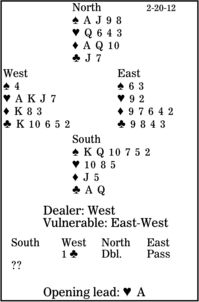Bridge column, February 20: Using a prompt to send a signal

If an actor forgets his next line, a prompter cues him. It is a signal to the actor to help him proceed. At the bridge table we also have cues. A cue-bid is not intended as natural and is made in a suit bid by an opponent. There are several different cue-bids that send various messages. The one that inexperienced players forget the most often occurs in today's deal.
West opens one club, North makes a takeout double, and East passes. What should South do?
A simple suit advance by an unpassed hand shows zero to 8 points. A jump advance indicates 9 to 11 points. With 12-plus points, the doubler's partner cue-bids the opener's suit. It is totally artificial, just prompting partner that he is facing a surprisingly strong hand. (If you are a passed hand, lower each of those ranges by two points.)
Over South's two-club cue-bid, North bids two hearts, South rebids two spades (forcing), and North raises to four spades.
West leads the heart ace, under which East signals with his nine, starting a high-low (echo) with a doubleton. West cashes the heart king and continues with the heart jack. East ruffs away dummy's queen, then shifts to a club. How should South play from there?
Given the bidding, the club finesse is doomed, but the diamond finesse is sure to win. South should win with his club ace, draw trumps, and run the diamond jack. He then plays a diamond to dummy's queen and discards his club loser on the diamond ace.
** ** **
COPYRIGHT 2012, UNITED FEATURE SYNDICATE
DISTRIBUTED BY UNIVERSAL UCLICK FOR UFS

